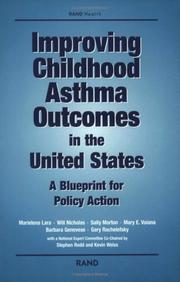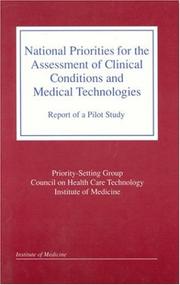| Listing 1 - 4 of 4 |
Sort by
|

ISBN: 0833032429 0833029975 9780833032423 9780833029973 Year: 2001 Publisher: Santa Monica Rand
Abstract | Keywords | Export | Availability | Bookmark
 Loading...
Loading...Choose an application
- Reference Manager
- EndNote
- RefWorks (Direct export to RefWorks)
An estimated five million US children have asthma. This report argues that many asthma attacks could be avoided - and much suffering prevented and many medical costs saved - if more children received good-quality, ongoing asthma care.
Asthma in children. --- Asthma in children - Government policy - United States. --- Asthma in children --- Asthma --- Treatment Outcome --- Health Policy --- Child --- Public Policy --- Respiratory Hypersensitivity --- Prognosis --- Bronchial Diseases --- Outcome Assessment (Health Care) --- Lung Diseases, Obstructive --- Age Groups --- Persons --- Outcome and Process Assessment (Health Care) --- Lung Diseases --- Respiratory Tract Diseases --- Social Control Policies --- Diagnosis --- Hypersensitivity, Immediate --- Quality of Health Care --- Hypersensitivity --- Diseases --- Policy --- Analytical, Diagnostic and Therapeutic Techniques and Equipment --- Social Control, Formal --- Named Groups --- Health Care Evaluation Mechanisms --- Immune System Diseases --- Health Care Economics and Organizations --- Social Sciences --- Health Services Administration --- Sociology --- Health Care --- Health Care Quality, Access, and Evaluation --- Anthropology, Education, Sociology and Social Phenomena --- Pediatrics --- Medicine --- Health & Biological Sciences --- Government policy --- Childhood asthma --- Allergy in children --- Pediatric respiratory diseases

ISBN: 0309042364 9786610212569 128021256X 0309564786 0585149143 9780585149141 9780309042369 0309078741 9780309078740 9780309564786 Year: 1990 Publisher: Washington, D.C. National Academy Press
Abstract | Keywords | Export | Availability | Bookmark
 Loading...
Loading...Choose an application
- Reference Manager
- EndNote
- RefWorks (Direct export to RefWorks)
Medical technology --- Clinical medicine --- Technology assessment --- Medical policy --- Medicine, Clinical --- Medicine
Book
ISBN: 1598753800 Year: 2002 Publisher: Santa Monica : RAND Corporation,
Abstract | Keywords | Export | Availability | Bookmark
 Loading...
Loading...Choose an application
- Reference Manager
- EndNote
- RefWorks (Direct export to RefWorks)
Over the course of 2000, RAND Health engaged an interdisciplinary committee of nationally recognized leaders in childhood asthma in a structured group process to arrive at the policy recommendations proposed in Improving Childhood Asthma Outcomes in the United States: A Blueprint for Policy Action, by M.
Asthma in children. --- Asthma in children - Government policy - United States. --- Asthma --- Health Policy --- Treatment Outcome --- Child --- Prognosis --- Outcome Assessment (Health Care) --- Lung Diseases, Obstructive --- Public Policy --- Age Groups --- Respiratory Hypersensitivity --- Bronchial Diseases --- Persons --- Outcome and Process Assessment (Health Care) --- Lung Diseases --- Social Control Policies --- Respiratory Tract Diseases --- Hypersensitivity, Immediate --- Diagnosis --- Policy --- Social Control, Formal --- Diseases --- Quality of Health Care --- Hypersensitivity --- Health Care Evaluation Mechanisms --- Social Sciences --- Health Care Economics and Organizations --- Immune System Diseases --- Health Services Administration --- Sociology --- Health Care --- Health Care Quality, Access, and Evaluation
Book

Year: 2020 Publisher: Santa Monica, Calif. RAND Corporation
Abstract | Keywords | Export | Availability | Bookmark
 Loading...
Loading...Choose an application
- Reference Manager
- EndNote
- RefWorks (Direct export to RefWorks)
To fulfill Congress's requirement for an economic and disaster-recovery plan for Puerto Rico following Hurricanes Irma and Maria, a team from the Homeland Security Operational Analysis Center conducted an analysis for the government of Puerto Rico and the Federal Emergency Management Agency (FEMA). The team assessed the hurricanes' effect on Puerto Rico's municipalities and the municipalities' ability to govern, deliver services, and recover from the damage they incurred. To address information gaps in Puerto Rico, the team surveyed officials from all 78 municipal governments, conducted 12 regional roundtables with municipal officials, collected and analyzed available municipal-level data, and consulted with subject-matter experts. The team's analysis shows that municipal governments faced the hurricanes while dealing with severe fiscal constraints caused by declining income — something that complicated response and recovery efforts. FEMA data revealed that the most–heavily affected municipalities were clustered in the southeast coast of the main island, where Maria made landfall, and the central mountainous region, where the rugged terrain exacerbated the hurricane's effects. The team created a framework to evaluate the rate at which different municipalities are recovering, which revealed that the most–heavily damaged municipalities are generally also the ones recovering most slowly. Finally, working with the government of Puerto Rico and FEMA, the team developed a set of courses of action (COAs) for recovery aimed at improving municipalities' capacity to govern and deliver key services. These COAs focus on improving municipal fiscal conditions, implementing regional approaches to service delivery and planning, rebuilding urban centers, increasing transparency, and enhancing municipal capacity.
Municipal government --- Hurricane damage --- Hurricane Irma, 2017. --- Hurricane Maria, 2017. --- Puerto Rico.
| Listing 1 - 4 of 4 |
Sort by
|

 Search
Search Feedback
Feedback About UniCat
About UniCat  Help
Help News
News